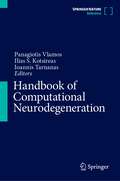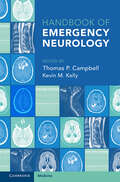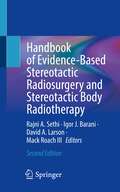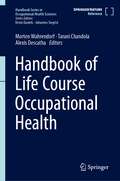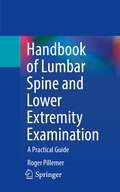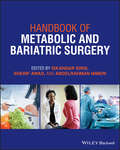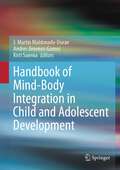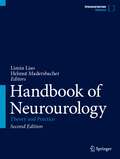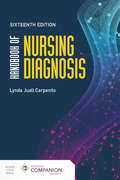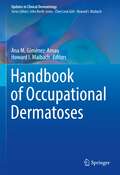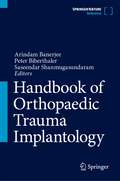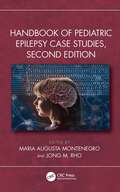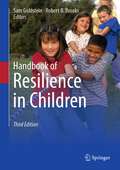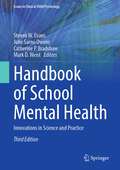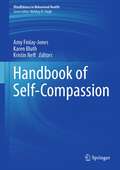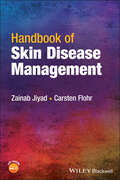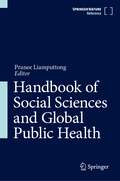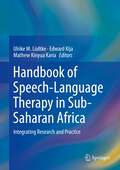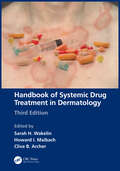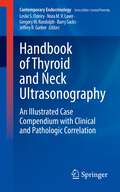- Table View
- List View
Handbook of Computational Neurodegeneration
by Ilias S. Kotsireas Panagiotis Vlamos Ioannis TarnanasThe Handbook of Computational Neurodegeneration provides a comprehensive overview of the field and thus bridges the gap between standard textbooks of research on neurodegeneration and dispersed publications for specialists that have a narrowed focus on computational methods to study this complicated process. The handbook reviews the central issues and methodological approaches related to the field for which the reader pursues a thorough overview. It also conveys more advanced knowledge, thus serving both as an introductory text and as a starting point for an in-depth study of a specific area, as well as a quick reference source for the expert by reflecting the state of the art and future prospects. The book includes topics that are usually missing in standard textbooks and that are only marginally represented in the specific literature. The broad scope of this handbook is reflected by five major parts that facilitate an integration of computational concepts, methods and applications in the study of neurodegeneration. Each part is intended to stand on its own, giving an overview of the topic and the most important problems and approaches, which are supported by examples, practical applications, and proposed methodologies. The basic concepts and knowledge, standard procedures and methods are presented, as well as recent advances and new perspectives.
Handbook of Emergency Neurology: Handbook For Emergency Physicians
by Thomas P. Campbell Kevin M. KellyPatients with neurologic symptoms are frequently seen in the emergency department and require rapid and thorough evaluation. Appropriate assessment with tailored history-taking, localization of the neurological problem, differential diagnosis, focused testing, and urgent treatment when indicated are essential to prevent patient morbidity. Neurological examination and testing of patients are covered in-depth, along with common neurological presentations using a symptom-based approach, such as coma, dizziness and gait disturbance. Specific neurological disorders are also explored, including traumatic brain injury, ischemic stroke and transient ischemic attack and neurotoxicology. Chapters follow a basic outline, including an introduction and a pearls and pitfalls section, providing a succinct overview and key takeaway points for the busy clinician. This well organized handbook will serve as a concise, valued reference for the clinician to use in assisting the evaluation of the most common neurology related emergency department visits.
Handbook of Evidence-Based Stereotactic Radiosurgery and Stereotactic Body Radiotherapy
by Mack Roach III Rajni A. Sethi Igor J. Barani David A. LarsonThis handbook concisely summarizes state-of-the-art information about stereotactic radiosurgery (SRS) and stereotactic body radiotherapy (SBRT), including the history and development of these modalities, the biologic rationale for these technologies, typical practices, and reported results. Developed as a companion to Handbook of Evidence-Based Radiation Oncology, edited by Eric Hansen and Mack Roach, III, it is organized by disease site and presents treatment techniques and recommended imaging; safety and quality assurance; toxicities and management; recommended follow-up; and supporting evidence. Inclusion of evidence-based guidelines is intended to help inform decisions regarding the appropriateness of SRS and SBRT and guide treatment and evaluation. This new edition is fully updated with the latest literature. A new chapter on dose constraints has also been added, along with additional content on SBRT for oligometastatic disease and prostate, and the integration of SBRT with systemic therapy, including chemotherapy, immunotherapy, targeted agents. Case examples are added, as well as additional images to highlight situations described. Handbook of Evidence-Based Stereotactic Radiosurgery and Stereotactic Body Radiotherapy, 2e can be easily referenced in the clinic and is a valuable guide for radiation oncology practitioners
Handbook of Fire and the Environment: Impacts and Mitigation (The Society of Fire Protection Engineers Series)
by Brian J. Meacham Margaret McNameeThe fundamental purpose of this handbook is to raise awareness about environmental impacts of fire and fire suppression, primarily within the fire engineering and firefighting communities, but also within the environmental engineering and planning disciplines. The Handbook provides readers with a fundamental understanding of the problem and its magnitude and includes a set of tools and methods for assessing environmental, social and financial impacts, and a set of tools for identifying and selecting appropriate mitigation options.
Handbook of Gynecology
by Donna ShoupeThis book is a comprehensive, up-to-date reference on general and subspecialty gynecology. Covering all aspects of gynecology commonly encountered in day-to-day practice, this exhaustive and fully updated new edition provides a practical, one-stop reference work for clinicians working in the field.This carefully-designed volume includes ten sections, beginning with comprehensive coverage of office-based gynecology, and continuing on to present disease processes and management information by patient age group. Each chapter includes background information, current recommendations for screening, diagnostic criteria, common and uncommon associated problems, approach to diagnosis, summary of treatment options, and an overview of ICD-10 codes for specific diagnoses. Importantly, many areas that are covered in the handbook as subspecialty problems are pertinent and important information to many of the general practitioners who handle and develop some expertise in these areas. These include ovulation induction, medical management of incontinence, management of abnormal Pap smears, and work-up of abnormal bleeding. The handbook concludes with an easy-to-navigate presentation of minimally-invasive operations, surgical procedures, neoplasms, and pathology. Advantages and risks associated with management of particular diseases are covered, along with multiple tips for avoiding complications.This second edition is fully updated. With extensive updates on cervical cancer screening, pelvic organ prolapse, and more, many chapters will be completely rewritten to reflect the latest guidelines, procedures, and methods of care in women’s health. The text additionally includes two new chapters, covering the impact of COVID on gynecology care, and the work-up and surgical management of chronic pelvic pain.This is an ideal guide for practicing gynecologists, family and internal medicine physicians, physician assistants, nurse practitioners, fellows, residents, medical students, and all women’s health care providers.
Handbook of Life Course Occupational Health (Handbook Series in Occupational Health Sciences)
by Morten Wahrendorf Tarani Chandola Alexis DescathaThis handbook provides a comprehensive overview of recent developments in research on the relationship between occupational trajectories over the life course and health. It uncovers the impact of far-reaching changes of work and employment, as evidenced by increased flexibility, discontinuity, and technological innovation, and offers insights into recent theoretical and methodological developments addressing this challenge. In its main parts, it presents the best evidence to readers about the following topics: early life influences on (un)healthy work, chronic exposure to occupational risks; nonstandard employment and poor health; work continuation with chronic disease; occupational determinants of healthy aging. In its final part, it discusses policy implications of current knowledge and points to the need of developing new solutions in research and practice, not least in times of climate crisis and the new pandemic.The important handbook has been prepared by a distinguished editorial team, with chapters written by prominent international experts. Despite its continuous reference to scientific knowledge it addresses its content to a broader, non-specialized readership.
Handbook of Lumbar Spine and Lower Extremity Examination: A Practical Guide
by Roger PillemerIn addition to complementary radiographic imaging, the physical exam is an essential diagnostic element for the orthopedic surgeon. As such, learning to perform this exam thoroughly is of utmost importance to medical students, residents and interns on an orthopedic rotation and in later practice.This practical text succinctly presents all of the necessary information regarding the physical examination of the lower extremity and lumbar spine. The lower spine, hip, knee, and foot and ankle are discussed in dedicated thematic sections, with each section comprised of three main chapters. The initial chapter describes the musculoskeletal anatomy and function of the joint, presenting the tests themselves along with the rationale for performing them. The second chapter presents the systematic examinations carried out in every case, and the third chapter describes examinations for specific conditions relating to the joint, including tendinopathies, osteoarthritis, neurological conditions, deformities and more. Plentiful bullet points and color images throughout the text describe and illustrate each test and physical sign.Convenient and user-friendly, Handbook of Lumbar Spine and Lower Extremity Examination is a valuable, portable guide to this all-important diagnostic tool for students and practitioners alike.
Handbook of Metabolic and Bariatric Surgery
by Iskandar Idris Sherif Awad Abdelrahman NimeriHANDBOOK OF METABOLIC AND BARIATRIC SURGERY Discover the essentials involved in the management of metabolic and bariatric surgery in this easy-to-read and well-illustrated guide The management of severe obesity and its related co-morbidities, including diabetes, has become one of the most important aspects of modern medicine. The most effective and lasting treatment for these conditions is bariatric and metabolic surgery, which has become more in demand from patients and doctors. Since many non-surgical specialists contribute to treating these patients, there is an increasing need for medical professionals to develop a working knowledge of patient requirements surrounding these operations. Handbook of Metabolic and Bariatric Surgery provides a concise, accessible guide to the management of bariatric and metabolic surgery patients. It approaches its subject from both endocrine and surgical perspectives, covering pre-, peri- and post-operative requirements for commonly undertaken surgical procedures, as well as guidance for managing metabolic, psychological, and surgical aspects. It promises to become a valuable guide to this increasingly important field. Handbook of Metabolic and Bariatric Surgery readers will also find: Over 150 full-color images and illustrations; A thorough introduction to the subject of obesity medicine and the history of bariatric and metabolic surgery; An editorial team with both research and practical clinical experience. Handbook of Metabolic and Bariatric Surgery is a useful reference for any non-surgical medical professional or researcher working within the field of obesity medicine and surgery.
Handbook of Mind/Body Integration in Child and Adolescent Development
by J. Martin Maldonado-Duran Andres Jimenez-Gomez Kirti SaxenaThe Handbook of Mind/Body Integration in Child and Adolescent Development examines issues relating to the mind/body connection in the development of children and adolescents, addressing problems of adverse life experiences with clinical implications, including somatization, functional or unexplained medical disturbances in various organ systems, psychosomatic conditions, and the effects. It discusses the interactions of emotions, experiences, thoughts in the mind – and their manifestations in the body – of children and youth. The book describes the effects of bodily conditions on the emotional state and mental functioning of children, such as cerebral palsy, major medical conditions, and other chronic health problems. It also explores the effects of chronic stress as well as child neglect and abuse on bodily manifestations.Key areas of coverage include:Developmental issues in the embodiment of self and body image in children and adolescents.Trauma and mind/body consequences in children and adolescents.Munchausen syndrome by proxy.Unexplained medical conditions, somatoform disorders, and conversion disorders during childhood and adolescence, including unexplained conditions in different organ systems (e.g., gastrointestinal, dermatological, neurological).Body/mind conditions in youth with physical and intellectual disabilities and chronic or severe medical conditions, including palliative care.Complementary and alternative treatment approaches to mind/body issues in children and adolescents, supplementing the usual mental health interventions.The Handbook of Mind/Body Integration in Child and Adolescent Psychiatry is an essential resource for researchers, professors, and graduate students as well as clinicians, therapists, and related professionals in developmental psychology, child and adolescent psychiatry, family therapy, social work, pediatrics, and public health.
Handbook of Neurourology: Theory and Practice
by Limin Liao Helmut MadersbacherThis book introduces neurourology as an emerging interdisciplinary area that covers the basic and clinical studies of the neural control on the normal lower urinary tract and the lower/upper urinary tract dysfunction due to neuropathy disorders. It systematically describes all aspects of neurourology from the epidemiology of the neurogenic bladder; to the pathology and pathophysiology of the lower urinary tract; to the diagnosis and treatment of the neurogenic bladder by conservative therapies or surgeries. This book provides a useful resource for medical doctors, nurses and students in the field of neurourological conditions.In this 2nd edition, 15 chapters are added, e.g. on urodynamic practice, psychogenic reasons of LUTDs, standard of care, physiotherapy, upper urinary tract rehabilitation to enable self-catheterization, pediatric neurourology, new surgical procedures. The editors have invited an impressive number of renowned contributors, including 98 internationally recognized specialists in this field from 25 countries in Europe, Asia, North America, and South America. This handbook provides a useful resource for medical doctors, nurses and students in the field of neurourological conditions.
Handbook of Nursing Diagnosis
by Lynda Juall CarpenitoLynda Carpenito’s best-selling, Handbook of Nursing Diagnosis, now in an impressive sixteenth edition, is the ideal quick reference for nursing diagnosis information. This trusted handbook covers the NANDA-I Nursing Diagnoses 2021-2023 and offers practical guidance on nursing diagnoses and associated care. The quick-reference type scope of content makes it easy for students to use while in clinical, in the classroom or simulation lab. From goals to specific interventions, Handbook of Nursing Diagnosis focuses on nursing. It provides a condensed, organized outline of clinical nursing practice designed to communicate creative clinical nursing. It is not meant to replace nursing textbooks, but rather to provide nurses who work in a variety of settings with the information they need without requiring a time-consuming review of the literature. It will assist students in transferring their theoretical knowledge to clinical practice.
Handbook of Occupational Dermatoses (Updates in Clinical Dermatology)
by Howard I. Maibach Ana M. Giménez-ArnauThis handbook offers a comprehensive overview of the variety of skin issues that can arise while at work. It is meant to guide dermatologists, allergists, and industrial physicians in the successful diagnostic and management of the patients suffering from occupational skin dermatoses. It provides a look at the current modes of treatment available to practicing physicians while also offering updates on the most recent changes and advances for easy integration into practice. With an depth look at some of the more common diseases, like various urticaria and eczema as well as examining specific work places prone to exposure, this book will provide a quick and easy-to-use reference. Chapters contain patient photos and offer a multidisciplinary approach with special chapters on medical legal implications as well as exploring the minimum standards on prevention, diagnosis, and treatment as viewed worldwide. Handbook of Occupational Dermatoses is a must-have resource for dermatologists, allergists, and primary care physicians that deal with these skin issues everyday.
Handbook of Orthopaedic Trauma Implantology
by Arindam Banerjee Peter Biberthaler Saseendar ShanmugasundaramThis reference work comprehensively covers essential orthopedic trauma implants and their application in both upper and lower limbs. It offers insights into the invention, advantages, and disadvantages of various implants, along with the rationale behind their current designs, biomechanics, and materials. Additionally, the book addresses fracture fixation and general considerations when comparing different subgroups of implants, such as nails versus plates or ORIF versus external fixation.The book is divided into several sections, such as upper and lower limbs, spine, and pelvis. It also includes unique sections dedicated to pediatric implants, implant removal, metallurgy and bone grafts. It is written and edited by experienced surgeons from around the world. This book fills the gap as currently, there are no specific reference books on this topic but only operative manuals and inventory lists of various commercial companies detailing their own products.This highly informative and meticulously presented book serves as both a practical and a theoretical guide for practicing orthopedic surgeons, scientists/researchers, academicians, students as well as orthopedic technicians and nurses.
Handbook of Pediatric Epilepsy Case Studies, Second Edition
by Jong M. Rho Maria Augusta MontenegroResearch in the field of epilepsy will continue at a rapid pace, with the ultimate hope of curing many intractable epilepsy syndromes. Fully updated, this new edition is organized chronologically, from neonate through adolescence, and the handbook is the culmination of a group effort involving leading physicians and researchers whose contributions constitute a concise and practical reference for health professionals in training. Here the contributors review the recent flood of new information on the pathophysiology, genetics, and treatment of the various epilepsy syndromes, and the volume is distilled into an easy-to-use guide. Fully updated text reviewing the latest research on the pathophysiology, genetics, and treatment of the various epilepsy syndromes. Thorough descriptions of the different syndromes commonly encountered in clinical practice across the pediatric range. Extensive resource section provided. Contributors describe why they chose each particular case, what they learned, and how it changed their practice. The book includes the most recent classification and nomenclature published by the International League Against Epilepsy.
Handbook of Resilience in Children
by Sam Goldstein Robert B. BrooksThe third edition of this handbook addresses not only the concept of resilience in children who overcome adversity, but it also explores the development of children not considered at risk addressing recent challenges as a consequence of the COVID-19 pandemic. The new edition reviews the scientific literature that supports findings that stress-hardiness and resilience in all children leads to happier and healthier lives as well as improved functionality across the lifespan. In this edition, expert contributors examine resilience in relation to environmental stressors as phenomena in child and adolescent disorders and as a means toward positive adaptation into adulthood. The significantly expanded third edition includes new and significantly revised chapters that explore strategies for developing resilience in families, clinical practice, and educational settings as well as its nurturance in caregivers and teachers. Key areas of coverage include: Exploration of the four waves of resilience research. Resilience in gene-environment transactions. Resilience in boys and girls. Resilience in family processes. Asset building as an essential component of intervention. Assessment of social and emotional competencies related to resilience. Building resilience through school bullying prevention. Resilience in positive youth development. Enhancing resilience through effective thinking. The Handbook of Resilience in Children, Third Edition, is an essential reference for researchers, clinicians and allied practitioners, and graduate students across such interrelated disciplines as child and school psychology, social work, public health as well as developmental psychology, special and general education, child and adolescent psychiatry, family studies, and pediatrics.
Handbook of School Mental Health: Innovations in Science and Practice (Issues in Clinical Child Psychology)
by Mark D. Weist Steven W. Evans Julie Sarno Owens Catherine P. BradshawThe handbook provides thoughtful and provocative critiques of the science and practice of school mental health. It examines intervention science and implementation science and the study of professional development and stakeholder engagement. The volume outlines the relevant issues facing the field of school mental health and provides a framework for the areas of study. Chapters critique the science in a specific area, draw innovative connections between findings, and present new information about their area of expertise. This handbook provides a concise and critical update of the literature in school mental health and is an essential resource for those from the wide range of disciplines that constitute the science and practice of school mental health. Key topics featured include: Promoting meaningful engagement and leadership in school mental health by diverse stakeholders.Training, coaching, and workforce development in school mental health.Intervention science for children with specific needs (e.g., anxiety, depression, trauma, autism).Innovations in scaling-up and Implementation science, focusing on such topics as multitiered systems of support and scaleup of positive behavior support strategies. The handbook is an essential reference for researchers, graduate students, and other professionals in child and school psychology, special and general education, public health, school nursing, occupational therapy, psychiatry, social work and counseling, educational policy, and family advocacy.
Handbook of Self-Compassion (Mindfulness in Behavioral Health)
by Kristin Neff Amy Finlay-Jones Karen BluthThis handbook examines contemporary issues in self-compassion science and practice. It describes advances in the conceptualization and measurement of self-compassion as well as current evidence from cross-sectional and experimental research. The volume addresses the foundational issues of self-compassion, including its relationship to self-esteem and mindfulness. In addition, it considers the developmental origins of self-compassion and its relevance across the life course, including among adolescents and older adults. The handbook explores the role of self-compassion in promoting well-being and resilience and addresses new frontiers in self-compassion research, such as the neural underpinnings and psychophysiology of compassionate self-regulationKey areas of coverage include:The meaning of self-compassion for gender and sexuality minority groups.The cultivation of self-compassion among young people.The use of interventions to promote self-compassion.The role of compassion-based interventions in clinical contexts.Important insights for using self-compassion-based interventions in practice.The Handbook of Self Compassion is a must-have resource for researchers, professors, and graduate students as well as clinicians, therapists, and other practitioners in psychology, complementary and alternative medicine, and social work as well as all interrelated research disciplines and clinical practices.
Handbook of Skin Disease Management
by Zainab Jiyad Carsten FlohrHandbook of Skin Disease Management Learn the essential information necessary to manage patients with skin diseases in this brand-new compact handbook Skin diseases severely impact quality of life and management of these conditions can be exceptionally challenging, particularly when first and second-line treatments have failed. The Handbook of Skin Disease Management is the first handbook specifically developed with the focus on the management aspect of dermatological conditions. It is designed to be used by busy clinicians who need relevant information quickly and includes an A-Z format with succinct entries loaded with essential information. Incorporating evidence bases and success rates for each potential treatment, it includes everything clinicians need to rapidly familiarize themselves with the different treatment options. Handbook of Skin Disease Management readers will also find: Treatment of over 40 conditions, listed alphabetically for easy reference A visually enhanced guide to prescribing systemics Over 20 key lists, such as differentials for blistering diseases, telangiectasia, and more Handbook of Skin Disease Management is a vital reference for clinicians working with dermatological patients, particularly trainees and junior doctors. “What a refreshing change to see such a succinct book full of useful practical advice that can be used in the clinic. Zainab Jiyad and Carsten Flohr succeed in that difficult task of bridging the gap between evidence and practice.” —Hywel Williams, OBE, NIHR Senior Investigator Emeritus, FMedSci Professor of Dermato-Epidemiology and Co-Director, Centre of Evidence-Based Dermatology Centre of Evidence-Based Dermatology, University of Nottingham, UK “I wish I had such a useful handbook during my early career! Zainab Jiyad and Carsten Flohr have produced a great guide on the management of common skin diseases for dermatology trainees, consultants and GPs, packed with the latest evidence from guidelines and systematic reviews.”—Phyllis Spuls, Professor of Evidence-Based Dermatology, Amsterdam University Medical Centers, The Netherlands
Handbook of Social Sciences and Global Public Health
by Pranee LiamputtongThis handbook highlights the relevance of the social sciences in global public health and their significantly crucial role in the explanation of health and illness in different population groups, the improvement of health, and the prevention of illnesses around the world. Knowledge generated via social science theories and research methodologies allows healthcare providers, policy-makers, and politicians to understand and appreciate the lived experience of their people, and to provide sensitive health and social care to them at a time of most need. Social sciences, such as medical sociology, medical anthropology, social psychology, and public health are the disciplines that examine the sociocultural causes and consequences of health and illness. It is evident that biomedicine cannot be the only answer to improving the health of people. What makes social sciences important in global public health is the critical role social, cultural, economic, and political factors play in determining or influencing the health of individuals, communities, and the larger society and nation. This handbook is comprehensive in its nature and contents, which range from a more disciplinary-based approach and theoretical and methodological frameworks to different aspects of global public health. It covers: Discussions of the social science disciplines and their essence, concepts, and theories relating to global public health Theoretical frameworks in social sciences that can be used to explain health and illness in populations Methodological inquiries that social science researchers can use to examine global public health issues and understand social issues relating to health in different population groups and regionsExamples of social science research in global public health areas and concerns as well as population groups The Handbook of Social Sciences and Global Public Health is a useful reference for students, researchers, lecturers, practitioners, and policymakers in global health, public health, and social science disciplines; and libraries in universities and health and social care institutions. It offers readers a good understanding of the issues that can impact the health and well-being of people in society, which may lead to culturally sensitive health and social care for people that ultimately will lead to a more equitable society worldwide.
Handbook of Speech-Language Therapy in Sub-Saharan Africa: Integrating Research And Practice
by Ulrike M. Lüdtke Edward Kija Mathew Kinyua KariaThis book synthesizes research on language development and communication disability in Sub-Saharan Africa and highlights best practices for providing speech and language therapy services to individuals with language, communication, and hearing disorders across the lifespan. The book brings together a wide range of international contributions from various disciplines, such as speech-language pathology, audiology, developmental psychology, language education, social work, neurology, neuropsychology, pediatrics, linguistics, pedagogy, and phonetics to provide perspectives on problems, challenges, ideas, concepts, and models to serve the people in Sub-Saharan Africa.
Handbook of Speech-Language Therapy in Sub-Saharan Africa: Integrating Research and Practice
by Ulrike M. Lüdtke Edward Kija Mathew Kinyua KariaThis book synthesizes research on language development and communication disability in Sub-Saharan Africa and highlights best practices for providing speech and language therapy services to individuals with language, communication, and hearing disorders across the lifespan. The book brings together a wide range of international contributions from various disciplines, such as speech-language pathology, audiology, developmental psychology, language education, social work, neurology, neuropsychology, pediatrics, linguistics, pedagogy, and phonetics to provide perspectives on problems, challenges, ideas, concepts, and models to serve the people in Sub-Saharan Africa. Key areas of coverage include:Challenges for speech-language therapists in the health sector.Community awareness and the sustainable delivery of services.Culture-specific support of communication and language development in early childhood.Malnutrition, dysphagia, feeding difficulties, pediatric HIV, and related issues.Communication disability treatments, including assessment and intervention, augmentative and alternative communication (AAC), and issues specific to bilingualism and biliteracy.Inclusive education of children with communication disorders with case studies from Rwanda, Tanzania, Kenya, and South Africa. The Handbook of Speech-Language Therapy in Sub-Saharan Africa is an essential reference for researchers, professors, and graduate students as well as clinicians, therapists, and other professionals in developmental psychology, speech-language pathology and therapy, social work, neuropsychology, pediatrics, special education, community based rehabilitation, and all related disciplines.
Handbook of Systemic Drug Treatment in Dermatology
by Howard I. Maibach Sarah H. Wakelin Clive B. ArcherThe Handbook of Systemic Drug Treatment in Dermatology helps prescribers and patients make rational decisions about drug treatment while considering known risks and potential unwanted effects. Written for dermatologists, family practitioners, pharmacists and specialist nurses, this completely revised and updated third edition of a bestseller provides an accessible and concise aid to prescribing and monitoring systemic dermatologic therapy. For each drug or drug class, the book lists its classification, mode of action, formulations, dosages, suggested regimens, contraindications, important drug interactions, adverse effects, patient information, and more. This third edition includes new classes of drugs as well as information on updated guidelines for prescribing and monitoring established drugs.FROM REVIEWS OF PREVIOUS EDITIONS"This updated edition includes new arrivals… Quite simply, it is indispensable! I have it with me in every clinic and often refer to it in discussions with pharmacists (who have been known to borrow my copy and forget to return it)." Dermatology in Practice "... an outstanding resource that helps to alleviate worrying by providing precise guidelines and advice in managing our most infirm patients who require these medications." SkinMed
Handbook of Targeted Cancer Therapy and Immunotherapy
by Daniel D. Karp Gerald S. Falchook JoAnn D. LimDesigned for quick, everyday reference, Handbook of Targeted Cancer Therapy and Immunotherapy, 3rd Edition, includes clinical trial results of more than 250 state-of-the-art targeted therapy and immunotherapy agents, providing a practical, intuitive, colorful overview of this rapidly advancing field. Comprehensive yet concise, this easy-access resource by Drs. Daniel D. Karp, Gerald S. Falchook, and JoAnn D. Lim, helps you navigate through the newest research reports and apply the most recent discoveries as they pertain to specific tumor types, actionable molecular targets, and clinical performance of investigational targeted agents and combinations of agents. This handbook presents information distilled by dozens of translational research clinicians and other healthcare experts with hundreds of years of cumulative experience in the revolutionary area of genomically based precision oncology.
Handbook of Targeted Cancer Therapy and Immunotherapy: Breast Cancer
by Debu Tripathy Senthil DamodaranDesigned for quick, everyday reference, Handbook of Targeted Cancer Therapy and Immunotherapy: Breast Cancer provides a practical overview of this rapidly advancing field. Comprehensive yet concise, this easy-access resource by Drs. Senthil Damodaran and Debu Tripathy of MD Anderson Cancer Center helps you filter and apply the most recent discoveries as they pertain to specific tumor types, actionable molecular targets, and clinical performance of approved or investigational targeted agents and combinations of agents.
Handbook of Thyroid and Neck Ultrasonography: An Illustrated Case Compendium with Clinical and Pathologic Correlation (Contemporary Endocrinology)
by Gregory W. Randolph Jeffrey R. Garber Leslie S. Eldeiry Nora M. V. Laver Barry SacksIncidentally discovered thyroid nodules and palpable neck masses present a common clinical problem. Further evaluation with neck ultrasound helps to characterize these lesions and stratify the risk of malignancy. Based on ultrasound characteristics, these lesions can be better defined using pathologic and other clinical data in order to determine the best management. This practical handbook is a case compendium based on thyroid and neck ultrasonography patterns that are commonly encountered in clinical practice. A chapter will be designated for each of the major types of thyroid nodule ultrasound features, and additional chapters will be designated for other non-thyroid neck lesions. Beginning with imaging (photographic) examples of each of the ultrasound findings, clinical cases will be used to subdivide each feature and illustrate the differential diagnoses of the various types of thyroid and neck lesions. Associated cytology and histopathology images will be shown and described, as well as clinical data, including relevant history, physical exam, molecular marker results and clinical course. Chapters will include bulleted key points for quick reference as well as suggested readings for further investigation.While several handbooks exist to educate readers about neck and thyroid ultrasonography and about cytopathology, this is a unique work that combines ultrasound and pathology data into a case-based, easy-to-read and concise format that fits in your pocket, adapting common terminology that is emerging for ultrasound, which will allow readers to employ a "standardized" approach to evaluating nodules, depending on the risk scoring system used.
